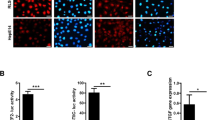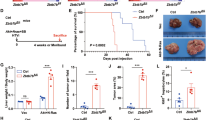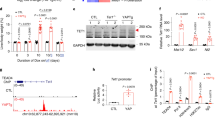Abstract
The oncogene yes-associated protein (YAP) is a key modifier of liver homeostasis and regulates mitosis in hepatocytes as well as in malignantly transformed cells. However, the question of how YAP supports cell proliferation in hepatocellular carcinoma (HCC) is not well understood. Here we identified U2AF momology motif kinase 1 (UHMK1) as a direct transcriptional target of YAP and the transcription factor forkhead box M1 (FOXM1), which supports HCC cell proliferation but not migration. Indeed, UHMK1 stimulates the expression of genes that are specific for cell cycle regulation and which are known downstream effectors of YAP. By using BioID labeling and mass spectrometry, the dimerization partner, RB-like, E2F and multi-vulval class B (DREAM) complex constituent MYB proto-oncogene like 2 (MYBL2, B-MYB) was identified as a direct UHMK1 interaction partner. Like YAP, UHMK1 stimulates nuclear enrichment of MYBL2, which is associated HCC cell proliferation and the expression of the cell cycle regulators CCNB1, CCNB2, KIF20A, and MAD2L1. The association between YAP, UHMK1, MYBL2, and proliferation was confirmed in YAPS127A-transgenic mice and human HCC tissues. In summary, we provide a model by which YAP supports cell proliferation through the induction of important cell cycle regulators in a UHMK1- and MYBL2-dependent manner.
This is a preview of subscription content, access via your institution
Access options
Subscribe to this journal
Receive 50 print issues and online access
$259.00 per year
only $5.18 per issue
Buy this article
- Purchase on Springer Link
- Instant access to full article PDF
Prices may be subject to local taxes which are calculated during checkout




Similar content being viewed by others
References
Yu FX, Zhao B, Guan KL. Hippo pathway in organ size control, tissue homeostasis, and cancer. Cell. 2015;163:811–28.
Eisinger-Mathason TS, Mucaj V, Biju KM, Nakazawa MS, Gohil M, Cash TP, et al. Deregulation of the Hippo pathway in soft-tissue sarcoma promotes FOXM1 expression and tumorigenesis. Proc Natl Acad Sci USA. 2015;112:E3402–3411.
Zhao B, Ye X, Yu J, Li L, Li W, Li S, et al. TEAD mediates YAP-dependent gene induction and growth control. Genes Dev. 2008;22:1962–71.
Benhamouche S, Curto M, Saotome I, Gladden AB, Liu CH, Giovannini M, et al. Nf2/Merlin controls progenitor homeostasis and tumorigenesis in the liver. Genes Dev. 2010;24:1718–30.
Dong J, Feldmann G, Huang J, Wu S, Zhang N, Comerford SA, et al. Elucidation of a universal size-control mechanism in Drosophila and mammals. Cell. 2007;130:1120–33.
Song H, Mak KK, Topol L, Yun K, Hu J, Garrett L, et al. Mammalian Mst1 and Mst2 kinases play essential roles in organ size control and tumor suppression. Proc Natl Acad Sci USA. 2010;107:1431–6.
Tschaharganeh DF, Chen X, Latzko P, Malz M, Gaida MM, Felix K, et al. Yes-associated protein up-regulates Jagged-1 and activates the Notch pathway in human hepatocellular carcinoma. Gastroenterology. 2013;144:1530–42 e1512.
Weiler SME, Pinna F, Wolf T, Lutz T, Geldiyev A, Sticht C, et al. Induction of chromosome instability by activation of Yes-associated protein and forkhead box M1 in liver cancer. Gastroenterology. 2017;152:2037–51 e2022.
Johnson R, Halder G. The two faces of Hippo: targeting the Hippo pathway for regenerative medicine and cancer treatment. Nat Rev Drug Discov. 2014;13:63–79.
Maucuer A, Camonis JH, Sobel A. Stathmin interaction with a putative kinase and coiled-coil-forming protein domains. Proc Natl Acad Sci USA. 1995;92:3100–4.
Boehm M, Yoshimoto T, Crook MF, Nallamshetty S, True A, Nabel GJ, et al. A growth factor-dependent nuclear kinase phosphorylatesp 27(Kip1) and regulates cell cycle progression. EMBO J. 2002;21:3390–401.
Langenickel TH, Olive M, Boehm M, San H, Crook MF, Nabel EG. KIS protects against adverse vascular remodeling by opposing stathmin-mediated VSMC migration in mice. J Clin Invest. 2008;118:3848–59.
Carter SL, Eklund AC, Kohane IS, Harris LN, Szallasi Z. A signature of chromosomal instability inferred from gene expression profiles predicts clinical outcome in multiple human cancers. Nat Genet. 2006;38:1043–8.
Roux KJ, Kim DI, Raida M, Burke B. A promiscuous biotin ligase fusion protein identifies proximal and interacting proteins in mammalian cells. J Cell Biol. 2012;196:801–10.
Schopp IM, Amaya Ramirez CC, Debeljak J, Kreibich E, Skribbe M, Wild K, et al. Split-BioID a conditional proteomics approach to monitor the composition of spatiotemporally defined protein complexes. Nat Commun. 2017;8:15690.
Manceau V, Kremmer E, Nabel EG, Maucuer A. The protein kinase KIS impacts gene expression during development and fear conditioning in adult mice. PLoS ONE. 2012;7:e43946.
Guiley KZ, Liban TJ, Felthousen JG, Ramanan P, Litovchick L, Rubin SM. Structural mechanisms of DREAM complex assembly and regulation. Genes Dev. 2015;29:961–74.
Manceau V, Kielkopf CL, Sobel A, Maucuer A. Different requirements of the kinase and UHM domains of KIS for its nuclear localization and binding to splicing factors. J Mol Biol. 2008;381:748–62.
Cancer Genome Atlas Research Network. Comprehensive and integrative genomic characterization of hepatocellular carcinoma. Cell. 2017;169:1327–41 e1323.
Calvisi DF, Simile MM, Ladu S, Frau M, Evert M, Tomasi ML, et al. Activation of v-Myb avian myeloblastosis viral oncogene homolog-like2 (MYBL2)-LIN9 complex contributes to human hepatocarcinogenesis and identifies a subset of hepatocellular carcinoma with mutant p53. Hepatology. 2011;53:1226–36.
Guan Z, Cheng W, Huang D, Wei A. High MYBL2 expression and transcription regulatory activity is associated with poor overall survival in patients with hepatocellular carcinoma. Curr Res Transl Med. 2018;66:27–32.
Panciera T, Azzolin L, Cordenonsi M, Piccolo S. Mechanobiology of YAP and TAZ in physiology and disease. Nat Rev Mol Cell Biol. 2017;18:758–70.
Zanconato F, Forcato M, Battilana G, Azzolin L, Quaranta E, Bodega B, et al. Genome-wide association between YAP/TAZ/TEAD and AP-1 at enhancers drives oncogenic growth. Nat Cell Biol. 2015;17:1218–27.
Xu MZ, Chan SW, Liu AM, Wong KF, Fan ST, Chen J, et al. AXL receptor kinase is a mediator of YAP-dependent oncogenic functions in hepatocellular carcinoma. Oncogene. 2011;30:1229–40.
Qiao Y, Chen J, Lim YB, Finch-Edmondson ML, Seshachalam VP, Qin L, et al. YAP regulates actin dynamics through ARHGAP29 and promotes metastasis. Cell Rep. 2017;19:1495–502.
Petrovic V, Costa RH, Lau LF, Raychaudhuri P, Tyner AL. FoxM1 regulates growth factor-induced expression of kinase-interacting stathmin (KIS) to promote cell cycle progression. J Biol Chem. 2008;283:453–60.
Bieche I, Manceau V, Curmi PA, Laurendeau I, Lachkar S, Leroy K, et al. Quantitative RT-PCR reveals a ubiquitous but preferentially neural expression of the KIS gene in rat and human. Brain Res Mol Brain Res. 2003;114:55–64.
Manceau V, Swenson M, Le Caer JP, Sobel A, Kielkopf CL, Maucuer A. Major phosphorylation of SF1 on adjacent Ser-Pro motifs enhances interaction with U2AF65. FEBS J. 2006;273:577–87.
Sadasivam S, DeCaprio JA. The DREAM complex: master coordinator of cell cycle-dependent gene expression. Nat Rev Cancer. 2013;13:585–95.
Acknowledgements
We thank M. Bissinger and J. Schmitt for excellent technical assistance, Dr. A. Ori for providing us with the BirA vector, as well as T. R. Brummelkamp and F. D. Camargo for providing Col1A1-YAPS127A transgenic mice. Tissue samples were provided by the tissue bank of the National Center of Tumor Diseases (Heidelberg, Germany) in accordance with the regulations of the tissue bank and the approval of the Ethics Committee of Heidelberg University. We also thank the Center of Model System and Comparative Pathology (CMCP; Dr. F. Lasitschka, Dr. T. Poth) and H. Conrad for their support. This study was supported by a grant from the German Cancer Aid (Deutsche Krebshilfe/Dr. Mildred Scheel Stiftung, to K.B., DKH 111524), the SFB/TR 209 “Liver Cancer” (to K.B., S.S., and P.S.), the priority program SPP1782/2 (to K.B.), and the China Scholarship Council/CSC (to T.W.). J.U.M. is supported by grants from the German Research Foundation (MA 4443/2-2) and the Volkswagen Foundation (Lichtenberg program).
Author information
Authors and Affiliations
Corresponding author
Ethics declarations
Conflict of interest
The authors declare that they have no conflict of interest.
Additional information
Publisher’s note: Springer Nature remains neutral with regard to jurisdictional claims in published maps and institutional affiliations.
Rights and permissions
About this article
Cite this article
Wei, T., Weiler, S.M.E., Tóth, M. et al. YAP-dependent induction of UHMK1 supports nuclear enrichment of the oncogene MYBL2 and proliferation in liver cancer cells. Oncogene 38, 5541–5550 (2019). https://doi.org/10.1038/s41388-019-0801-y
Received:
Revised:
Accepted:
Published:
Issue Date:
DOI: https://doi.org/10.1038/s41388-019-0801-y
This article is cited by
-
Exploration of a hypoxia-immune-related microenvironment gene signature and prediction model for hepatitis C-induced early-stage fibrosis
Journal of Translational Medicine (2024)
-
From modulation of cellular plasticity to potentiation of therapeutic resistance: new and emerging roles of MYB transcription factors in human malignancies
Cancer and Metastasis Reviews (2024)
-
α-catenin interaction with YAP/FoxM1/TEAD-induced CEP55 supports liver cancer cell migration
Cell Communication and Signaling (2023)
-
FOXM1-induced TYMS upregulation promotes the progression of hepatocellular carcinoma
Cancer Cell International (2022)
-
UHMK1 aids colorectal cancer cell proliferation and chemoresistance through augmenting IL-6/STAT3 signaling
Cell Death & Disease (2022)



